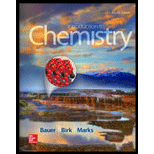
Concept explainers
(a)
Interpretation:
The volume of
(a)
Explanation of Solution
Given Information:
The given ionic reaction given is:
The molarity of
So, moles of solute can be calculated by rearranging the equation (1).
Moles of
The mole ratio of the reaction is:
Volume of
So,
(b)
Interpretation:
The mass of
(b)
Explanation of Solution
Given Information:
The given ionic reaction is:
To calculate the mass of
The molar mass of
So,
Want to see more full solutions like this?
Chapter 11 Solutions
Introduction to Chemistry
- Arsenic acid, H3AsO4, is a poisonous acid that has been used in the treatment of wood to prevent insect damage. Arsenic acid has three acidic protons. Say you take a 25.00-mL sample of arsenic acid and prepare it for titration with NaOH by adding 25.00 mL of water. The complete neutralization of this solution requires the addition of 53.07 mL of 0.6441 M NaOH solution. Write the balanced chemical reaction for the titration, and calculate the molarity of the arsenic acid sample.arrow_forwardA 25.0-mL sample of sodium sulfate solution was analyzed by adding an excess of barium chloride solution to produce barium sulfate crystals, which were filtered from the solution. Na2SO4(aq)+BaCl2(aq)2NaCl(aq)+BaSO4(s) If 5.719 g of barium sulfate was obtained, what was the molarity of the original Na2SO4 solution?arrow_forwardA student is asked to identify the metal nitrate present in an aqueous solution. The cation in the solution can be either Na+, Ba2+, Ag+, or Ni2+. Results of solubility experiments are as follows: unknown + chloride ions—no precipitate unknown + carbonate ions—precipitate unknown + sulfate ions—precipitate What is the cation in the solution?arrow_forward
- A 0.608-g sample of fertilizer contained nitrogen as ammonium sulfate, (NH4)2SO4. It was analyzed for nitrogen by heating with sodium hydroxide. (NH4)2SO4(s)+2NaOH(aq)Na2SO4(aq)+2H2O(l)+2NH3(g) The ammonia was collected in 46.3 mL of 0.213 M HCl (hydrochloric acid), with which it reacted. NH3(g)+HCl(aq)NH4Cl(aq) This solution was titrated for excess hydrochloric acid with 44.3 mL of 0.128 M NaOH. NaOH(aq)+HCl(aq)NaCl(aq)+H2O(l) What is the percentage of nitrogen in the fertilizer?arrow_forwardFor a product to be called vinegar, it must contain at least 5.0% acetic acid, HC2H3O2, by mass. A 10.00-g sample of a raspberry vinegar is titrated with 0.1250 M Ba(OH)2 and required 37.50 mL for complete neutralization. Can the product be called a vinegar?arrow_forwardA 25.0-mL sample of vinegar (which contains the weak acid acetic acid, CH3CO2H) requires 28.33 mL of a 0.953 M solution of NaOH for titration to the equivalence point. What is the mass of acetic acid (molar mass = 60.05 g/mol), in grams, in the vinegar sample, and what is the concentration of acetic acid in the vinegar? CH3CO2H(aq) + NaOH(aq) NaCH3CO2(aq) + H2O(l)arrow_forward
- The exposed electrodes of a light bulb are placed in a solution of H2SO4 in an electrical circuit such that the light bulb is glowing. You add a dilute salt solution, and the bulb dims. Which of the following could be the salt in the solution? a. Ba(NO3)2 b. NaNO3 c. K2SO4 d. Ca(NO3)2 Justify your choices. For those you did not choose, explain why they are incorrect.arrow_forwardA soluble iodide was dissolved in water. Then an excess of silver nitrate, AgNO3, was added to precipitate all of the iodide ion as silver iodide, AgI. If 1.545 g of the soluble iodide gave 2.185 g of silver iodide, how many grams of iodine are in the sample of soluble iodide? What is the mass percentage of iodine, I, in the compound?arrow_forwardA 8.50 g sample of KCl is dissolved in 66.0 mL of water. The resulting solution is then added to 72.0 mL of a 0.280 M CaCl2(aq) solution. Assuming that the volumes are additive, calculate the concentrations of each ion present in the final solution.arrow_forward
 General Chemistry - Standalone book (MindTap Cour...ChemistryISBN:9781305580343Author:Steven D. Gammon, Ebbing, Darrell Ebbing, Steven D., Darrell; Gammon, Darrell Ebbing; Steven D. Gammon, Darrell D.; Gammon, Ebbing; Steven D. Gammon; DarrellPublisher:Cengage Learning
General Chemistry - Standalone book (MindTap Cour...ChemistryISBN:9781305580343Author:Steven D. Gammon, Ebbing, Darrell Ebbing, Steven D., Darrell; Gammon, Darrell Ebbing; Steven D. Gammon, Darrell D.; Gammon, Ebbing; Steven D. Gammon; DarrellPublisher:Cengage Learning Chemistry: Principles and ReactionsChemistryISBN:9781305079373Author:William L. Masterton, Cecile N. HurleyPublisher:Cengage Learning
Chemistry: Principles and ReactionsChemistryISBN:9781305079373Author:William L. Masterton, Cecile N. HurleyPublisher:Cengage Learning Introductory Chemistry: A FoundationChemistryISBN:9781337399425Author:Steven S. Zumdahl, Donald J. DeCostePublisher:Cengage Learning
Introductory Chemistry: A FoundationChemistryISBN:9781337399425Author:Steven S. Zumdahl, Donald J. DeCostePublisher:Cengage Learning Chemistry & Chemical ReactivityChemistryISBN:9781133949640Author:John C. Kotz, Paul M. Treichel, John Townsend, David TreichelPublisher:Cengage Learning
Chemistry & Chemical ReactivityChemistryISBN:9781133949640Author:John C. Kotz, Paul M. Treichel, John Townsend, David TreichelPublisher:Cengage Learning Chemistry: The Molecular ScienceChemistryISBN:9781285199047Author:John W. Moore, Conrad L. StanitskiPublisher:Cengage Learning
Chemistry: The Molecular ScienceChemistryISBN:9781285199047Author:John W. Moore, Conrad L. StanitskiPublisher:Cengage Learning Chemistry: Principles and PracticeChemistryISBN:9780534420123Author:Daniel L. Reger, Scott R. Goode, David W. Ball, Edward MercerPublisher:Cengage Learning
Chemistry: Principles and PracticeChemistryISBN:9780534420123Author:Daniel L. Reger, Scott R. Goode, David W. Ball, Edward MercerPublisher:Cengage Learning





